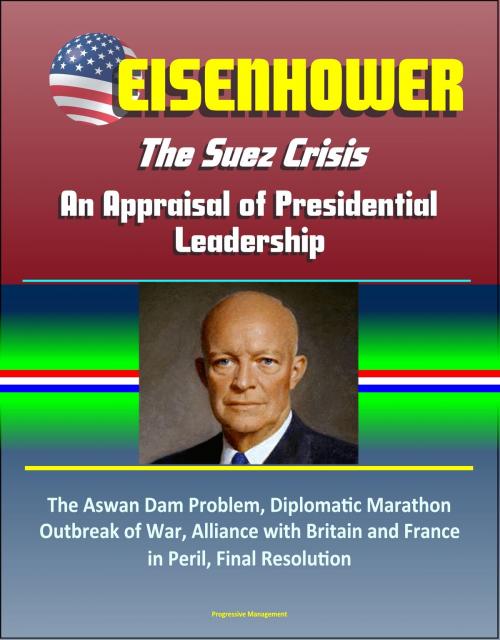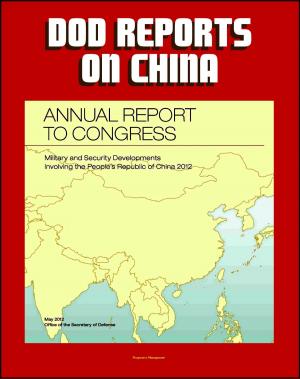Eisenhower: The Suez Crisis - An Appraisal of Presidential Leadership, The Aswan Dam Problem, Diplomatic Marathon, Outbreak of War, Alliance with Britain and France in Peril, Final Resolution
Nonfiction, History, Middle East, Social & Cultural Studies, Political Science| Author: | Progressive Management | ISBN: | 9781370044603 |
| Publisher: | Progressive Management | Publication: | March 16, 2017 |
| Imprint: | Smashwords Edition | Language: | English |
| Author: | Progressive Management |
| ISBN: | 9781370044603 |
| Publisher: | Progressive Management |
| Publication: | March 16, 2017 |
| Imprint: | Smashwords Edition |
| Language: | English |
This report has been professionally converted for accurate flowing-text e-book format reproduction.
The recent declassification of federal records for the decade of the 1950s has generated a total reappraisal of Eisenhower as an activist president and has prompted renewed interest in Eisenhower's involvement in foreign policy and his ability to manage the international crises that occurred during his Administration. The Suez crisis of 1956 is a valuable case for the examination of presidential leadership since the Middle East crisis was important and complex enough to engage the President in a full test of his ability as chief executive and crisis manager. How Eisenhower managed the White House and developed United States foreign policy during the Suez crisis is the focus of subsequent chapters. This examination of the primary documentation reinforces the revisionist view that Eisenhower did not delegate major foreign policy decisions to his subordinates. Rather, he maintained tight control of the decision-making process by organizing and supervising the security departments within the federal government in such a manner that it was only at the presidential level that all aspects of strategy and policy coalesced. The primary evidence clearly suggests that Eisenhower was not the passive chief executive his contemporaries labeled him, but an extraordinarily active president who utilized a unique style of leadership to achieve his political objectives.
The Suez crisis of 1956 is a valuable case for the examination of presidential decision-making and executive management. The President himself felt that no region of the world received as much of his close attention and that of his colleagues as did the Middle East. There against a background of new nations emerging from colonialism, in the thrusts of new Communist imperialism, and complicated by the old implacable hatred between Israeli and Arab, the world faced a series of crises. These crises posed a constant test to United States' will, principle, patience, and resolve.4 Suez was the most important Middle East crisis Eisenhower faced during his first Administration. Between July 1956 to mid-December 1956, Eisenhower remained locked in a fierce diplomatic confrontation that pitted Egyptian nationalism against European imperialism. Caught in the middle was the American President who pursued his own policies aimed at preventing the expanding influence of the Soviet Union into one of the world's most volatile regions.
Eisenhower's role in World War II was truly unique. Never before had a military commander been asked to accomplish a task of such magnitude as the conquest of Western Europe with such disparate forces and with such little real authority. What is more, Eisenhower's prescribed endstate was not a negotiated peace, but the enemy's "unconditional surrender"—a term that served great rhetorical purposes, but was never defined in either military or political terms. No one prior to World War II had ever held joint command of ground, air, and naval forces. No American had ever directed the combined forces of allied nations. Contemporary coalition commands that were formed in the Pacific, Middle East, and Southwest Asia were much less complex. They were generally focused exclusively on either land or sea operations, and all were much smaller. Eisenhower's massive unified command of joint and multinational forces was unparalleled in the war by either the Allies or the Axis.
This report has been professionally converted for accurate flowing-text e-book format reproduction.
The recent declassification of federal records for the decade of the 1950s has generated a total reappraisal of Eisenhower as an activist president and has prompted renewed interest in Eisenhower's involvement in foreign policy and his ability to manage the international crises that occurred during his Administration. The Suez crisis of 1956 is a valuable case for the examination of presidential leadership since the Middle East crisis was important and complex enough to engage the President in a full test of his ability as chief executive and crisis manager. How Eisenhower managed the White House and developed United States foreign policy during the Suez crisis is the focus of subsequent chapters. This examination of the primary documentation reinforces the revisionist view that Eisenhower did not delegate major foreign policy decisions to his subordinates. Rather, he maintained tight control of the decision-making process by organizing and supervising the security departments within the federal government in such a manner that it was only at the presidential level that all aspects of strategy and policy coalesced. The primary evidence clearly suggests that Eisenhower was not the passive chief executive his contemporaries labeled him, but an extraordinarily active president who utilized a unique style of leadership to achieve his political objectives.
The Suez crisis of 1956 is a valuable case for the examination of presidential decision-making and executive management. The President himself felt that no region of the world received as much of his close attention and that of his colleagues as did the Middle East. There against a background of new nations emerging from colonialism, in the thrusts of new Communist imperialism, and complicated by the old implacable hatred between Israeli and Arab, the world faced a series of crises. These crises posed a constant test to United States' will, principle, patience, and resolve.4 Suez was the most important Middle East crisis Eisenhower faced during his first Administration. Between July 1956 to mid-December 1956, Eisenhower remained locked in a fierce diplomatic confrontation that pitted Egyptian nationalism against European imperialism. Caught in the middle was the American President who pursued his own policies aimed at preventing the expanding influence of the Soviet Union into one of the world's most volatile regions.
Eisenhower's role in World War II was truly unique. Never before had a military commander been asked to accomplish a task of such magnitude as the conquest of Western Europe with such disparate forces and with such little real authority. What is more, Eisenhower's prescribed endstate was not a negotiated peace, but the enemy's "unconditional surrender"—a term that served great rhetorical purposes, but was never defined in either military or political terms. No one prior to World War II had ever held joint command of ground, air, and naval forces. No American had ever directed the combined forces of allied nations. Contemporary coalition commands that were formed in the Pacific, Middle East, and Southwest Asia were much less complex. They were generally focused exclusively on either land or sea operations, and all were much smaller. Eisenhower's massive unified command of joint and multinational forces was unparalleled in the war by either the Allies or the Axis.















